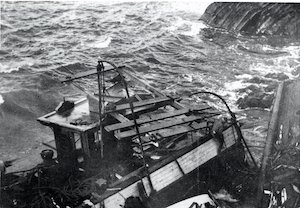
The Wreck of The Albion, 1913.
March 21, 1913 – The steam schooner Albion wrecked on the rocks at Stewart’s Point, 57 miles north of San Francisco.
While on her southbound trip from Bowen’s Landing for San Francisco, the Albion, commanded by Captain Victor Jacobson, put into Stewart’s Point early in the day to load railroad ties. At noon, after only part of the cargo had been taken on board, the sea began to run high, and Captain Jacobson put out from the coast.
The schooner was made fast to a buoy a few miles out, and her anchors were dropped, but the Albion refused to hold by its anchor and was swept by the gale toward the rocky coast. Shortly after 3 PM, the captain realized that he could not keep his vessel off the rocks, so he ordered the crew to the lifeboats. Less than half an hour later, the ship was pounding itself to pieces on the reef. The craft began to break up, and wreckage was scattered along the beach for several miles.
After struggling at the oars in two small open boats for more than three hours, the captain and crew landed on the beach south of Stewart’s Point about dusk. The men, fatigued from their labors, were sheltered by local residents.
The Albion was a wooden steam schooner built in 1892 by C. G. White in Alameda, California. She measured 120 x 31 x 9 feet with a single deck, and had a 110-horsepower compound 2-cylinder engine and a 250,000 board foot capacity.
“Thomas H. Petersen Master Shipbuilder” by Louis A. Hough. Thomas Petersen built about three dozen wooden vessels: sailing schooners, a barkentine, steam schooners, steam tugs and lighters. Based on Petersen’s memoirs. $15.